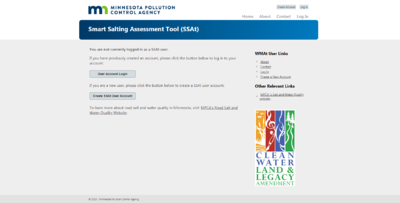
Difference between revisions of "Winter Maintenance Assessment tool (WMAt)"
m |
m |
||
| Line 15: | Line 15: | ||
*[http://ltiweb02.limno.com/WMAT/ Link to the Winter Maintenance Assessment tool (WMAt)] | *[http://ltiweb02.limno.com/WMAT/ Link to the Winter Maintenance Assessment tool (WMAt)] | ||
*[[How to create a WMAt account]] | *[[How to create a WMAt account]] | ||
| + | |||
| + | <noinclude> | ||
| + | ==Related pages== | ||
| + | *[[How salt works]] | ||
| + | *[[Environmental impacts of road salt]] | ||
| + | *[[Other impacts of road salt use]] | ||
| + | *[[Snow and salt storage]] | ||
| + | *[[Salt application BMPs]] | ||
| + | *[[Technology-based deicing BMPs]] | ||
| + | *[[Non-chloride chemical alternatives for deicing]] | ||
| + | *[[Emerging and non-traditional deicing BMPs]] | ||
| + | *[[Chloride Management Plan]] | ||
| + | *[[Winter Maintenance Assessment tool (WMAt)]] | ||
| + | *[[Winter Parking Lot and Sidewalk Maintenance Manual]] | ||
| + | *[[Smart Salting (S2) training information]] | ||
| + | *[[Smart Salting (S2) training certificate holders]] | ||
| + | *[[Educational resources for Smart Salting (S2)]] | ||
| + | *[[Cost-benefit considerations for Smart Salting (S2) and road salt winter maintenance]] | ||
| + | *[[Case studies for Smart Salting (S2) and road salt winter maintenance]] | ||
| + | *[[Chloride TMDL projects]] | ||
| + | *[[Links for Smart Salting (S2) and road salt winter maintenance]] | ||
| + | *[[References for Smart Salting (S2) and road salt winter maintenance]] | ||
| + | |||
| + | [[category:Road salt and de-icing]] | ||
| + | </noinclude> | ||
Revision as of 21:03, 29 January 2016
There are thousands of miles of streets and highways in Minnesota, along with parking lots and sidewalks that must be maintained to provide safe conditions throughout the winter. Winter maintenance of these surfaces currently relies heavily on the use of salt, primarily sodium chloride (NaCl), to prevent ice build-up and remove ice where it has formed.
In response to the increase in chloride concentrations from winter maintenance activities in area lakes, streams, wetlands, and groundwater, Minnesota state agencies, local municipalities, and experts across the Twin Cities Metropolitan Area (TCMA) have partnered to create a Chloride Management Plan to effectively manage salt use to protect our water resources in a responsible and strategic approach.
As part of the TCMA Chloride Management Plan development, the first of its kind, Winter Maintenance Assessment tool (WMAt) has been developed as a resource of all known salt saving best management practices (BMPs). The WMAt is a web‐based tool that can be used to assist public and private winter maintenance organizations in determining where opportunities exist to improve practices, make reductions in salt use and track progress.
The WMAt contains a list of roughly 180 BMPs that allows agencies and companies to complete an assessment of their current winter maintenance practices and speculate on potential future practices to understand how to reduce the use of chlorides, while still providing an acceptable level of service. Utilization of this planning tool will allow the user to track their progress over time and show the results of their efforts. It also can predict salt savings and associated cost savings (with a low degree of accuracy at this point) based on the industry’s current salt savings research.
Finally, once an assessment has been completed, a report can be generated summarizing current practices as “remedial”, “best” and “advanced” identifying areas for future improvement. The report is an excellent and convenient tool for winter maintenance managers to use to communicate winter maintenance operations to residents, clients or elected officials.
PLEASE NOTE: This WMAt was developed to help minimize the use of road salt on Minnesota parking lots, sidewalks and roadways. However, this tool works for any location where road salt is used as a de-icer. The MPCA created this tool in a web-based environment and encourages the use of the tool anywhere there is a need to minimize road salt use.
Related pages
- How salt works
- Environmental impacts of road salt
- Other impacts of road salt use
- Snow and salt storage
- Salt application BMPs
- Technology-based deicing BMPs
- Non-chloride chemical alternatives for deicing
- Emerging and non-traditional deicing BMPs
- Chloride Management Plan
- Winter Maintenance Assessment tool (WMAt)
- Winter Parking Lot and Sidewalk Maintenance Manual
- Smart Salting (S2) training information
- Smart Salting (S2) training certificate holders
- Educational resources for Smart Salting (S2)
- Cost-benefit considerations for Smart Salting (S2) and road salt winter maintenance
- Case studies for Smart Salting (S2) and road salt winter maintenance
- Chloride TMDL projects
- Links for Smart Salting (S2) and road salt winter maintenance
- References for Smart Salting (S2) and road salt winter maintenance
